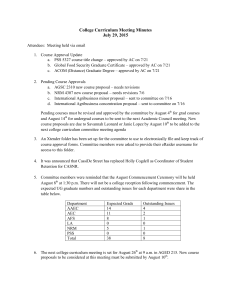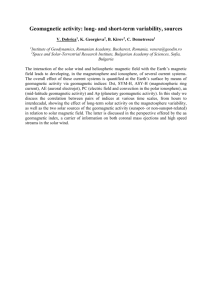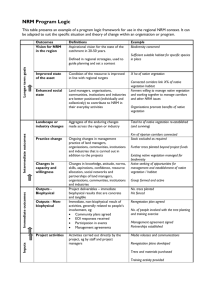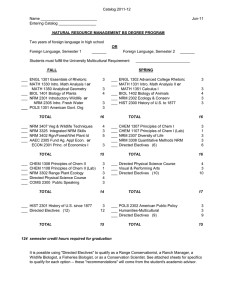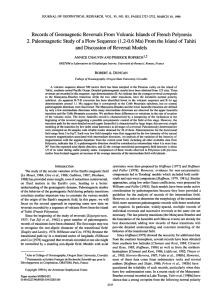Document 13148562
advertisement
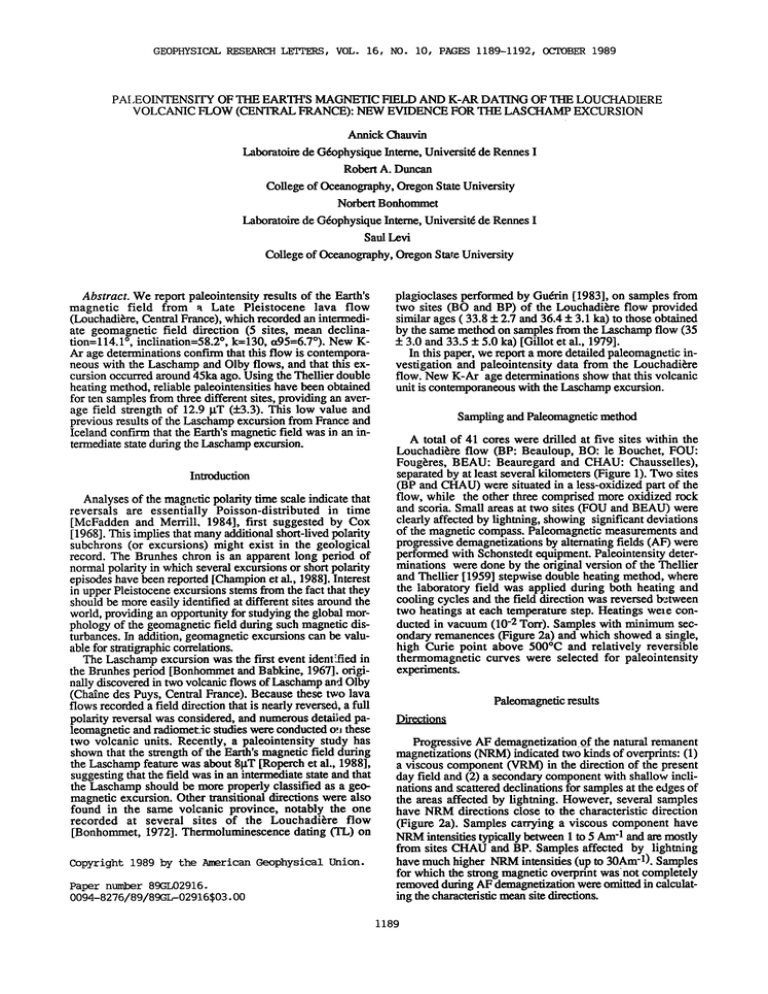
GEOPHYSICAL RESEARCH LETTERS,
PAI,EOINTENSITY
OF THE EARTH'S
VOL.
16,
MAGNETIC
NO.
FIELD
10,
PAGES 1189-1192,
AND K-AR
DATING
OCTOBER 1989
OF THE LOUCHADIERE
VOLCANIC FLOW (CENTRAL FRANCE): NEW EVIDENCE FOR THE LASCHAMP EXCURSION
Annick Chauvin
Laboratoirede G6ophysiqueInterne,Universit6de RennesI
Robert A. Duncan
Collegeof Oceanography,
OregonStateUniversity
Norbert Bonhommet
Laboratoirede G•ophysiqueInterne,Universit•de RennesI
Saul Levi
Collegeof Oceanography,
OregonStateUniversity
Abstract.We reportpaleointensityresultsof the Earth's
magnetic field from a Late Pleistocene lava flow
(Louchadi•re,CentralFrance),whichrecordedan intermediate geomagneticfield direction (5 sites, mean declination=114.1 ø, inclination=58.2ø, k=130, a95=6.7ø). New K-
Ar agedeterminations
confirmthatthisflow is contemporaneouswith the Laschampand Olby flows, and that this excursionoccurredaround45ka ago.UsingtheThellier double
heatingmethod,reliablepaleointensities
havebeenobtained
for ten samplesfrom threedifferentsites,providingan average field strengthof 12.9 gT (+3.3). This low value and
previousresultsof theLaschampexcursionfromFranceand
Icelandconfirm that the Earth'smagneticfield was in an intermedlatestateduringtheLaschampexcursion.
Introduction
Analysesof the magneticpolaritytime scaleindicatethat
reversals are essentially Poisson-distributed in time
[McFadden and Merrill, 1984], first suggestedby Cox
[ 1968].Thisimpliesthatmanyadditionalshort-lived
polarity
subchrons(or excursions)might exist in the geological
record. The Brunheschron is an apparentlong period of
normalpolarityin whichseveralexcursions
or shortpolarity
episodes
havebeenreported[Champion
et al., 1988].Interest
in upperPleistocene
excursions
stemsfrom thefactthatthey
shouldbe moreeasilyidentifiedat differentsitesaroundthe
world,providingan opportunityfor studyingtheglobalmor-
phologyof the geomagnetic
field duringsuchmagneticdisturbances.
In addition,geomagnetic
excursions
canbe valu-
plagioclasesperformedby Gudrin [1983], on samplesfrom
two sites (BO and BP) of the Louchadi•re flow provided
similarages( 33.8 + 2.7 and 36.4 + 3.1 ka) to thoseobtained
by the samemethodon samplesfrom theLaschampflow (35
+ 3.0 and 33.5 + 5.0 ka) [Gillot et al., 1979].
In thispaper,we reporta moredetailedpaleomagnetic
investigation and paleointensitydata from the Louchadi•re
flow. New K-Ar agedeterminations
showthat thisvolcanic
unit is contemporaneous
with the Laschampexcursion.
SamplingandPaleomagnefic
method
A total of 41 cores were drilled
ductedin vacuum(10-2 Torr).Samples
withminimumsec-
nallydiscovered
in twovolcanicflowsof Laschamp
andOlby
(ChainedesPuys,CentralFrance).Becausethesetwo lava
flows recordeda field directionthatis nearlyreversed,a full
polarityreversalwasconsidered,
andnumerous
detal•edpaleomagnetic
andradiomet.icstudies
wereconducted
o,l these
two volcanic units. Recently, a paleointensitystudy has
shownthat the strengthof the Earth'smagneticfield during
theLaschampfeaturewasabout8gT [Roperchet al., 1988],
suggesting
thatthefieldwasin anintermediate
stateandthat
the Laschampshouldbe moreproperlyclassifiedas a geomagneticexcursion.Othertransitional
directionswerealso
found in the same volcanic province, notably the one
at several
sites of the Louchadi•re
the
ondaryremanences(Figure2a) and which showeda single,
high Curie point above 500øC and relatively reversible
thermomagneticcurves were selectedfor paleointensity
experiments.
ablefor stratigraphic
correlations.
The Laschampexcursionwasthefirst eventident:.fied
in
the Brunhesperiod[Bonhommet
andBabkine,1967],origi-
recorded
at five sites within
Louchadi•re flow (BP: Beauloup, BO: le Bouchet, FOU'
Foug•res, BEAU: Beauregardand CHAU: Chausselles),
separatedby at leastseveralkilometers(Figure 1). Two sites
(BP and CHAU) were situatedin a less-oxidizedpart of the
flow, while the other three comprisedmore oxidized rock
and scotia. Small areas at two sites (FOU and BEAU) were
clearlyaffectedby lightning,showing significantdeviations
of the magneticcompass.Paleomagneticmeasurements
and
progressive
demagnetizations
by alternatingfields(AF) were
performedwith Schonstedt
equipment.Paleointensity
determinations were doneby the originalversionof the Thellier
and Thellier [ 1959] stepwisedoubleheatingmethod,where
the laboratory field was applied during both heating and
coolingcyclesand the field directionwas reversedbetween
two heatingsat each temperaturestep.Heatingswere con-
Paleomagnetic
results
Directions
ProgressiveAF demagnetization
of the naturalremanent
magnetizations
(NRM) indicatedtwo kindsof overprints:(1)
a viscouscomponent(VRM) in the directionof the present
day field and (2) a secondarycomponentwith shallowinclinationsand scattereddeclinationsfor samplesat the edgesof
the areasaffected by lightning. However, several samples
have NRM
flow
directions
close to the characteristic
direction
(Figure 2a). Samplescarrying a viscouscomponenthave
[Bonhommet,i972]. Thermoluminescence
dating (TL) on
NRMintensities
typically
between
1to5 Am-1andaremostly
from sitesCHAU and BP. Samplesaffected by lightning
Copyright 1989 by the American Geophysical Union.
have
much
higher
NRMintensities
(upto30Am'l).
Samples
Paper number 89GL02916.
0094-8276/89/89GL-02916503.00
for which the strongmagneticoverprintwasnot completely
removedduringAF demagnetization
wereomittedin calculating thecharacteristic
meansitedirections.
1189
1190
Chauvinet al.' Geomagnetic
Paleointensity
at Louchadi•re
TABLE
Volcano
53'
1. Site mean directions
45 ø
51'
FOU
.'
CHAU
Flow
I
nøuchadi/•re
!
I
Sites
n/N
D (o)
I (o)
k
et95
Fou
Beau
Chau
BP
130
6/10
8/11
5/6
6/8
6/6
119.0
123.1
102.3
109.8
117.0
Mean
5
114.1
Lat
Long
62.8
59.3
62.3
48.6
57.2
130
84
107
75
237
5.9
6.1
7.4
7.8
4.4
15.0
9.9
22.8
8.5
10.9
43.4
43.5
53.0
58.8
48.7
58.2
130
6.7
13.2
49.8
n/N: nmnberof samplesusedin the meancalculation/measured
Fig. 1. Locationmap and samplingsites(BO, BEAU, FOU,
BP and CHAU) of the Louchadi•reflow, Chainedes Puys,
parameterestimate,{x95:95% confidenceconeaboutthe mean;
France.
Lat, Long:latitudeandlongitudeof thevirtualgeomagnetic
pole.
N
N
ß
ß
(a) ß + .e o
+ ee
W
+30 (b)
o
4•60
'+ß++*•..+
++
eS•
ß
+
s
s
Fig. 2. a) Stereographic
projectionsof NRM directionsof all
samplescollectedfrom the Louchadi•reflow. Solid symbols
(open symbols) are on the lower (upper) hemisphere.
Diamondsare the directionsof the samplesselectedfor the
paleointensity
determinations.
b) Mean directionper si•esand
{x95confidencecones,after af andthermalcleaning.The star
represents
the dir•tion of the axial dipolefield.
The averagedirectionof thecharacteristic
magnetization
at
eachsiteis reportedin Table 1 and shownin Figure2b. The
mean direction of the flow (D= 114.1ø, I= 58.2 ø) shows a
large departure(42ø) from the axial dipole field and a low
VGP latitude (13.2ø).
Paleointensity
Eleven samplesfrom three sites(FOU, BEAU anJ BO)
wereusedfor paleointensity
experiments.
They were sel•ted
on the basisof havingminimumoverprint(Figure 2a), high
Curie points, and good reversibility between heating and
coolingin thermomagnetic
tests.Strongfield thermomagnetic
experimentson samplesfrom sitesBP and CHAU indicated
low Curie temperaturesdue to the relatively low oxidation
state of the Ti-rich titanomagnetites.Becausethis type of
mineralogyoftenlead to mineralogicalchangesduringheating, no samplesfrom thesetwo siteswere selected.During
the Thellier experiment,the sampleswere treatedin various
applied fields: 10, 15 and 20 gT. Numerouspartial thermoremanentmagnetization(TRM) checkswereperformedin
order to test the stability of TRM acquisitionduring the
heating[Pr6votet al., 1985].
Among the elevenselectedsamples,only one did not provide a paleointensity
resultdueto a drasticdecreasein the capacity of TRM acquisitionat temperaturesabove 410øC.
Table 2 summarizesthe paleointensityresults.From each
site,oneexampleof an NRM-TRM diagram andevolutionof
the NRM vector during the heatingare shownin Figure 3.
samples;
D, I: meandeclinationandinclinationpersite;k: precision
Althoughcoreswith large overprintswere avoided,samples
selectedfor paleointensity
measurements
werenot completely
free from small secondary¾RM components.However,
thesesecondarymagnetizationswere commonlyremovedat
temperaturebetween200 and 350øC.With the exceptionof
sample Beau-06a which is from a core that broke during
drilling, the NRM directions,in the temperatureintervalused
for paleointensitydeterminations,are similar to thosedeterminedby AF demagnetization.
At least 9 to 10 steps,and a large fraction of the NRM,
were usedto determinethepaleointensity.
The qualityfactor
q and the standarderror for single sampledeterminations
were calculatedfollowing the statisticalmethoddevelopedby
Coe et al. [1978]. The weightedaveragepaleointensity
of the
flow was obtainedusing the weightingfactor proposedby
Pr6vot et al. [ 1985]. The maximum error that CRM acquisition might have caused,in percentof the laboratoryf':eld,is
indicatedby the index R (Table 2), as definedby Coe et al.
[ 1984]. For our data,thisindexis typicallylessthan 10%.
The paleointensityresultsrange from 11 to 15 gT, with
only one determination,(22 gT, sampleBO-01), out of this
range. BO-01 has the lowestquality factor of all our specimens,soits contributionto the weightedmeanis least.•.mportant. The unweightedmean intensityof the flow is 17.9 gT,
and the weightedmean [Pr6votet al., 1985] consideredto be
thebestestimateof thepaleointensity
of the Louchadi•reflow
is 12.9 gT. This resultis one third to onequarterthe strength
of thepresentday field. The virtualdil•olemoment(¾DM)
associated
to thisflow is 2.2 1022Am2, whichis considerably less than the averageVDM obtainedfor the last 10 ka
[McElhinny and Senanayake, 1982] or the last 5
m.y.[McFadden and McElhinny, 1982], which is about 8.7
1022Am2.
Dating
K-Ar radiometricagedetermination
from samples
fromsite
BP providesan age (42 + 4 ka, Table 3) slightlyolderthan
thosedeterminedby thermoluminescence
[Gu6rin,1983]. A
40Ar-39Ar
incremental
heatingexperiment
yieldeda poorlyconstrained
plateauageof 39+28 ka. The agedeterminedby
K-Ar is also very similar to new measurements'•n the
LaschampandOlby flows (Table3). A goodinter-laboratory
consistency
betweenthesenewK-Ar dataandthoseobtained
'for Laschamp
andOlby samples[Gillotet al., 1979;Hall and
York, 1978] is observed.Significantagedifferencesseemto
occur betweenresultsobtainedby TL and K-Ar methods,
rather than between three different volcanic units.
Discussion
Another volcanic unit in the Chaine des Puys, the Royat
lava, recorded a magnetic direction (D=284.7ø; I=68.2 ø)
which deviatessignificantlyfrom normal secularvariation.
Chauvinet al.: Geomagnetic
Paleointensity
at Louchadibre
1191
TABLE 2. Paleointensity
results
Samples
Beau-02a
Beau-06a
Bo-01a
Bo-02a
Bo-03a
Bo-250a
Bo-252a
Fou-03a
Fou-04a
Fou-05a
D(ø)
145.0
104.0
110.5
111.5
117.0
123.0
126.5
108.0
113.0
110.0
I(ø)
60.0
86.0
57.5
54.5
64.0
53.0
58.0
59.5
63.0
60.5
N
Hlab JNRM
10
10
9
15
11
11
10
10
10
10
10
15
20
10
15
10
10
20
10
10
4.4
3.8
1.4
1.5
2.0
2.2
1.2
2.2
1.9
4.2
370-530
200-500
350-515
250-550
250-520
350-540
300-510
350-525
300-510
200-500
f
g
q
0.700
0.672
0.419
0.891
0.697
0.701
0.533
0.704
0.724
0.914
0.868
0.854
0.860
0.908
0.860
0.879
0.860
0.883
0.873
0.863
36.4
8.4
7.7
30.3
12.1
28.9
14.9
61.8
36.0
19.0
r
0.998
0.981
0.992
0.995
0.989
0.998
0.996
0.999
0.998
0.993
R%
Fe+sFe
18.6
3.4
11.5
1.9
2.6
10.3
7.9
3.2
3.6
3.5
11.0+_0.2
13.5+_0.9
22.4+_1.0
15.1_+0.4
15.5+0.8
11.2+-0.3
12.1+-0.4
12.3+_0.1
12.7+0.2
13.35:0.5
VDM = 2.2 x1022Am
2
<Fe> = 12.9
Mean: Fe q-s.d.= 13.9 !xT+-3.3
AT
D, I: magneticdeclination
andinclinationof theNRM left in theAT temperature
interval;N: numberof temperature
stepsin the AT
interval;
Hhb:
laboratory
field(in!.tT);
JNRM:
initial
intensity
ofmagnetization
inAm-1'AT:interval
oftemperature
used
tocalculate
thepaleointensity;
f, g, q: NRM fractionused,gapfactorandqualityfactorrespectively
[Coeet al., 1978];r: linearcorrelation
coefficient;R%: maximunpercentage
of CRM; Fe: paleointensity
estimatefor individualspecimen
in !xT;sFe:standarderror,Fe+-s.d.:
unweighted
averagepaleointensity
of theLouchadiirelavaflow plusor minusits standard
deviation;<Fe>: weightedmeanin !xT.
NRM
TABLE 3. K-Ar Ages
Up
N 1A/m
•1•
BEAU-02A
•zo
iwn
ONRM
o
N
BO-03A
52
'
1A/m
Down
1
NRM
250•
NRMo
TRM
N
"• .•
FOU-03A525•• E
'own
I
1
40At*
%40At* Age:!:1o
(x10
-13mole/g)
(ka)
Laschamp
Olby
1.857
1.733
1.578
1.148
2.8
1.8
49.0+-6.7
38.2+_6.3
Louchadi•re
1.677
1.213
3.0
41.7+_3.9
Decay andabundance
constants
usedin agecalculations:
•,e=0.581x10-10
yr-1,•,[5=4.962x10-10yr-1,
40K/K=l.167x10
-4
TRM
NRM
1
%K
mole/mole,
40Ar*:Radiogenic
40Ar
I
1
LavaFlow
TRM
Paleointensity determinations,performed by the Thellier
methodon sedimentsbakedby the Royat flow [Barbettiand
Flude, 1979], suggesta low field closeto 15 I.tT. The Royat
flow has been dated by TL at around 40-46 ka [Gu6rin,
1983]. Thus the Royat flow may have been eruptedat the
time of the Laschampexcursion.
The globalor regionalextentof the Laschampexcursionis
not, well defined.The only excursionrecordedin lavascorrelated with Laschampis in Iceland (D=258.0 ø, 1=-15.0ø)
[Kristjanssonand Gudmundsson,1980]. Palcointensitydeterminationsby the ThelEermethodhave beenperformedby
two groups and provide paleofields as low as 4.3 gT
[Marshall et al., 1988] and 4.2 gT [Levi et al., 1989]. K-Ar
radiometricage determinationsshow that theseflows were
eruptedaround40-50 ka and suggestcontemporaneitywith
the Laschampexcursion[Levi et al., 1989]. (A reverseddirection recorded in welded tuffs in Japan [Tanaka and
Tachibana,1981], was originallydatedat around30 ka, and
was first correlatedwith the Laschampexcursion.New dating of the tuff givesan agearound0.7 Ma, showingthat the
reversed direction was probably acquired during the
Fig. 3. Examplesof reliable paleointensitydeterminations
(NRM-TRM diagrams),for 3 samplesfrom the sitesBEAU,
BO, and FOU. Black dots are used to calculatethe slope;
trianglesrepresentPTRM checks;the associated
orthogonal
vector plots of the thermaldemagnetizationof the NRM are
shownin geographical(in situ) coordinateson the right of
eachNRM-TRM plot.Temperature
stepsareindicatedin øC.
1192
Chauvinet al.' GeomagneticPaleointensity
at Louchadibre
Matuyama period [Tanaka, 1988, personnalcommunication]).A very well definedintermediate
direction(D= 101.1ø,
I= -36.1o) wasrecentlymeasured
at 63 sitesof 8 distinctlava
flows of the AlbuquerqueVolcanos (New Mexico, USA)
[Geissmanet al., 1989]. Preliminary K-Ar age determinationssuggestlatestPleistocene
(i.e. 20 to 100ka) asthe time
of theextrusion.More preciseagedeterminations
arerequired
priorto moreexactcorrelation
withproposed
LatePleistocene
excursions.
Three modelshave been appliedto explain geomagnetic
excursions:(1) a dramaticchangein directionof the dipole
field; (2) a large increasein strengthof non-dipolesources;
and(3) a decreasein strengthof themaindipolefield causing
non-dipoledominationoverlargerportionsof theglobe.The
last hypothesiswasrecentlyusedin orderto interpretdirectionsandlow paleointensities
obtainedon the Laschampand
Olby flows [Roperchet al., 1988]. The low paleointensity
value observedat Louchadi•rereinforcesthis interpretation.
For example,a dipoleonly one fourthof the presentvalue
with non-dipole fields of the same order as presentnondipolefield valuescan produceregionalintermediatedirections.We may speculatethat sucha decreasein the dipole
field mighthavebeena first stepin an attemptedandfinally
abortedpolarityreversal.
Acknowledgments.
The authorsare gratefulto P. Roperch
for his help throughoutthis study.Financial supportfrom
INSU (France)and NSF are acknowledged.
References
Barbetti, M. and K. Flude, Palaeomagneticfield strengths
from sedimentsbaked by lava flows of the Chaine des
Puys,France,Nature, 278, 153-156, 1979.
Bonhommet, N., Sur la direction d'aimantation des laves de
la Chaine des Puys, et le comportementdu champterrestreen France au coursde l'6v•nementdu Laschamp.
Th•se, Universit• Louis Pasteur de Strasbourg,1972.
Bonhommet,N. and J. Bahkine, Sur la pr6sencede directions invers6esdans la Chaine des Puys, C. R. Acad.
$ci. Paris, 264, 92-94, 1967.
Champion, D.E., M.A., Lanphere and M.A., Kuntz,
Evidence for a new geomagneticreversal from Lava
flows in Idaho: Discussionof shortpolarityreversalsin
the Brunhes and late Matuyama polarity chrons, J.
Geophys.Res., 93, 11667-11680, 1988.
Coe, R.S., S. Gromm6 and E.A. Mankinen, Geomagnetic
paleointensitiesfrom excursionsequencesin lavas on
Oahu, Hawaii, J. Geophys.Res., 89, 1059-1069, 1984.
Coe, R.S., S. Gromm6 and E.A. Mankinen, Geomagnetic
paleointensitiesfrom radiocarbondated lava flows on
Hawaii andthe questionof thepacificnon-dipolelow, J.
Geophys.Res., 83, 1740-1756, 1978.
Cox, A., Lengths of geomagneticpolarity intervals, J.
Geophys.Res., 73, 3247, 1968o
Gillot, P.Y., J. Labeyrie, C. Laj, G. Valladas, G. Guerin,
G. PoupeauandG. Delibrias,Age of theLaschamppaleomagneticexcursionrevisited,Earth Planet. $ci. Lett.,
recordedduring the Late Pleistocene,Albuquerquevolcanos, New Mexico, USA, in Geomagnetism and
Paleomagnetism,edited by Lowes, F.J., et al., NATO
ASI seriesKluwer Academic Publishers, 123-136, 1989.
Gu6rin, G., La thermoluminescence des plagioclases.
M6thodede datationdu volcanisme.Applicationsau domainevolcaniquefran•ais:ChainedesPuys,Mont Dore
et Cezallier, Bas Vivarais, Th•se, Paris, 1983.
Hall, C.M. and D. York, K-Ar and 40Ar/39Ar age of the
Laschampgeomagneticpolarity reversal,Nature, 274,
462-464, 1978.
Kristjansson,L. and A. Gudmundsson,
Geomagneticexcursion in late-glacial basaltsoutcrops in south-western
Iceland, Geophys.Res. Lett., 7, 337-340, 1980.
Levi, S., H. Audusson,R.A. Duncan, L. Kristjansson,P.Y.
Gillot and S.P., Jakobson,Late Pleistocenegeomagnetic
excursion
in Icelandic
lavas:
Confirmation
1989.
Marshall, M., A. Chauvin and N. Bonhommet,Preliminary
paleointensitymeasurements
anddetailedmagneticanalysisof basaltsfrom the Skalamaelifellexcursion,southwest Iceland, J. Geophys. Res., 93, 11681-11698,
1988.
McElhinny, M.W. and W.E. Senanayake,Variationsin the
geomagnetic
dipole 1: The past50,000 years,J. Geomag.
Geoelectr., 34, 39-51, 1982.
McFadden,P.L. and M.W. McElhinny, Variationsof ihe geomagneticdipole 2: statisticalanalysisof ¾DMs for the
past 5 millions years,J. Geomag. Geoelectr.,34, 163189, 1982.
McFadden, P.L. and R.T. Merrill, Lower mantle convection
and geomagnetism,J. Geophys.Res., 89, 3354-3362,
1984.
Pr6vot, M., E.A. Mankinen, R.S. Coe and C.S. Gromm6,
The Steens Mountain (Oregon) geomagneticpolarity
transition.2 Field intensityvariationsand discussionof
reversal models, J. Geophys.Res., 90, 10417-10448,
1985.
Roperch,P., N. Bonhommetand S. Levi, Paleointensityof
the earth'smagneticfield duringthe Laschampexcursion,
andits geomagnetic
implications,Earth Planet.Sci.Lett.,
88, 209-219, 1988.
Tanaka,H. andK. Tachibana,A geomagneticreversalin the
latestBruhnesepochdiscoveredat Shibutami,Japon,J.
Geomag. Geoelectr., 33,287-292, 1981.
Thellier, E. and O. Thellier, Sur l'intensit6du champmagn6tique terrestredans le pass6historiqueet g6ologique,
Ann. Geophys.,15, 285-376, 1959
N. Bonhommet
and A.
Chauvin,
Laboratoire
L.D. McFadden,Bruhneschrongeomagneticexcursion
de
G6ophysiqueInterne,Universit6de RennesI, Av. G6n•ral
Leclerc, 35042 Rennes c6dex, France
R.A. Duncan and S. Levi, College of Oceanography,
Oregon State University, Ad. Bldg. 104, Corvallis, OR
97331-5503.
42, 444-450, 1979.
Geissman, J.W., S.S. Harlan, L. Brown, B. Turrin and
of the
Laschampexcursion.In pressEarth Planet. Sci. Lett. ,
(ReceivedApril 3, 1989;
acceptedSeptember1, 1989)


